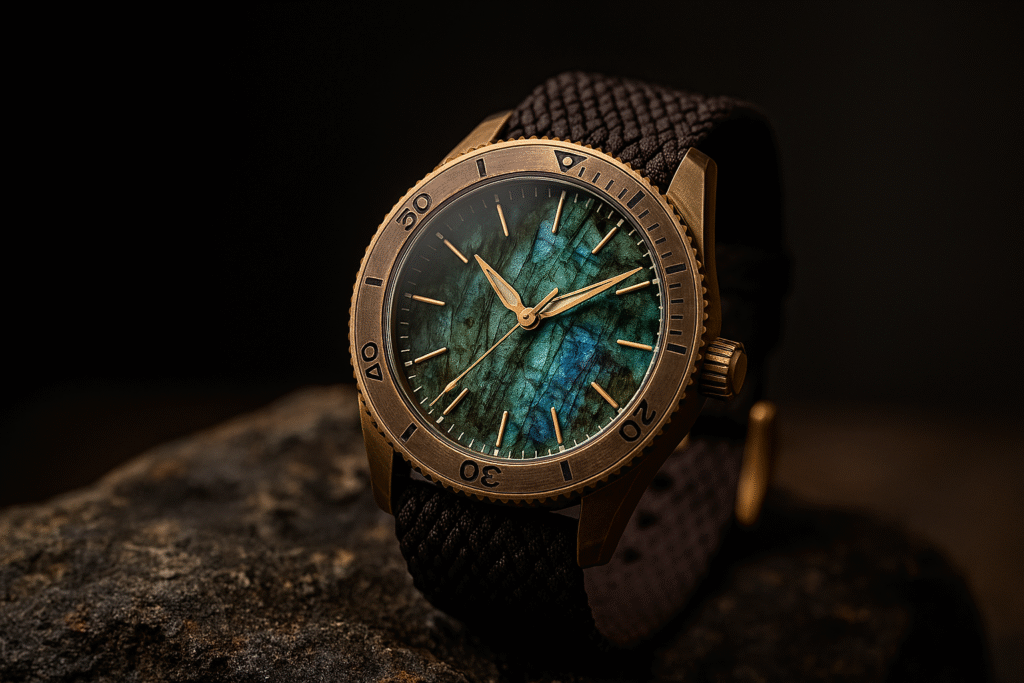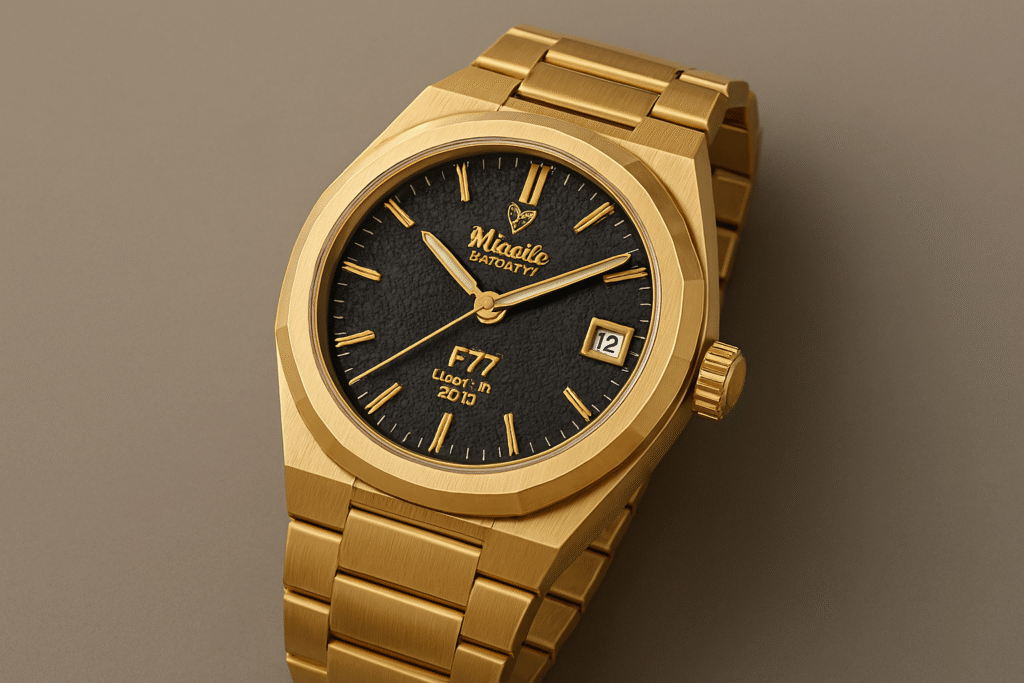Introduction
The Signum Cero Bronze Labradorite Watch is a unique collector’s timepiece. It combines a natural Labradorite dial, CuSn8 bronze case, Japanese automatic movement, and evolving patina. Each watch is one-of-a-kind, offering a dynamic piece that changes over time. Explore related watches in the gemstone watch guide.
Labradorite Dial in the Signum Cero Watch
The dial is crafted from Labradorite, a feldspar mineral first discovered in Labrador, Canada.
- Base colors: deep blue or purple
- Flashes of gold, yellow, or violet appear at certain angles
- Each dial is completely unique
Collectors who enjoy stone dials may also find the stone dial collector’s guide useful. The Labradorite’s natural optical effect ensures no two watches look alike.
Bronze Case and Patina Development
The CuSn8 bronze case comes in 39.5mm and 42.5mm. Bronze reacts naturally with air and moisture, forming a patina that gives each watch a personal character. Learn more in my bronze watch care guide.
Patina development depends on wear and climate, giving every timepiece a unique story. Collectors often prefer leaving the patina untouched for its aesthetic value.
NH35 and NH38 Japanese Movements
The Cero offers:
- NH35 automatic with lumed date disc
- NH38 automatic without date
These movements are widely trusted in microbrand watches (Seiko Instruments). For more details, see the NH35 vs NH38 guide or the automatic watch movement overview.
Why Collectors Choose the Signum Cero Bronze Labradorite Watch
- Unique stone dial patterns
- Patina evolves differently for every wearer
- Light reveals dynamic flashes of color
This combination of natural stone, bronze aging, and reliable movement makes the Signum Cero Bronze Labradorite Watch highly valued among collectors.
FAQ
Q: Will my dial match the photos?
A: Each dial is unique; flashes appear only at certain angles.
Q: How fast does patina form?
A: Usually within weeks, depending on humidity and air exposure.
Q: Can I polish the bronze case?
A: Yes, though most collectors prefer the natural patina.
Q: Why is the NH35 movement popular?
A: Known for precision and durability (Seiko Instruments).
Q: What case sizes are available?
A: 39.5mm or 42.5mm, with optional date or no-date.
This comprehensive global cuisine FAQ covers everything about Asian and Western food and drinks. Whether you’re exploring international cooking techniques or discovering new flavors, this global cuisine FAQ answers the most frequently asked questions about world food traditions, ingredients, and culinary practices from both Eastern and Western cultures.
Global Cuisine FAQ: Asian & Western Food & Drinks
Food reveals cultural contrasts in clear and delicious ways. From cooking methods to dining customs, Asian and Western cuisines showcase unique traditions while also offering fascinating overlaps. Below, you’ll find answers to the most common questions about these culinary worlds.
Understanding Core Differences in Cuisine
1. What distinguishes Asian and Western culinary traditions?
Asian meals often rely on rice or noodles as a foundation. Flavors usually come from soy sauce, ginger, garlic, and a wide variety of spices. Meanwhile, Western gastronomy emphasizes bread, potatoes, and pasta. Dairy plays a key role, with butter, cream, and cheese giving richness to many dishes. Herbs such as rosemary and thyme highlight European cooking. These contrasts create distinct dining habits and flavor profiles.
2. Are Asian dishes always spicy?
No, not at all. While cuisines from Thailand and parts of India feature bold use of chilies, not every dish follows this pattern. Japanese sushi, Chinese dim sum, and Korean bulgogi are mild examples. In fact, Asian cuisines range from fiery to delicate, showcasing a rich palette of flavor.
Western Breakfast Staples and Comfort Foods
1. What constitutes typical Western morning meals?
Western breakfasts often include eggs, bacon, and toast. Pancakes, waffles, and cereal are also popular choices. These hearty starts are usually enjoyed with coffee, tea, or juice, providing both energy and comfort.
2. What represents popular Western comfort foods?
Comfort foods in the West speak to nostalgia and indulgence. Creamy macaroni and cheese, pizza, and hearty casseroles are favorites. Similarly, burgers and fried chicken have wide appeal. Because they are warm, filling, and familiar, these dishes strongly connect to emotion.
Cultural Dining Practices
1. Do all Asian cultures employ chopsticks?
No. Chopsticks dominate in East Asia—China, Japan, and Korea. However, Southeast Asia prefers spoons and forks, while India and parts of the Middle East often use flatbreads or hands. This diversity highlights how food customs closely reflect culture.
2. Why are some Asian foods fermented?
Fermentation preserves food while also enhancing nutrition and flavor. Korean kimchi, Japanese miso, and Indonesian tempeh show how tradition meets health benefits. These foods are valued not only for taste but also for their role in well-being.
Common Western Beverages
1. What beverages are common with Western meals?
Western dining often features water, soda, or fresh juice. Alcohol also has a strong cultural connection, with wine served at European dinners and beer central in North America. In the southern United States, sweet iced tea is a staple.
Dietary Flexibility and Options
1. Can one discover plant-based options easily?
Yes. Asian cuisines offer tofu stir-fries, lentil dals, and vegetable curries that are naturally vegetarian. Western food, similarly, embraces plant-based eating. Salads, vegetarian pastas, and vegan burgers have grown popular, making meat-free dining accessible worldwide.
Unique Asian Drinks to Explore
1. What are some unique Asian beverages?
Asia provides a wide variety of distinctive drinks. Bubble tea, from Taiwan, combines tea with chewy tapioca pearls. Japanese sake, made from rice, holds deep cultural meaning. Strong Vietnamese iced coffee, sweetened with condensed milk, adds a bold twist compared to Western brews.
Portion Sizes and Dining Habits
1. How do portion sizes compare?
Western meals often emphasize large servings, reflecting abundance. By contrast, Asian meals are usually smaller yet balanced, encouraging sharing and mindful eating. This creates different social experiences around the table.
The Art of Fusion Cuisine
1. Is it feasible to integrate Asian and Western flavors?
Absolutely. Fusion cuisine blends traditions in creative ways. For instance, teriyaki burgers combine Japanese flavors with American fast food, while kimchi tacos bring Korean spice to Mexican street food. These playful mixes show how food bridges cultures.


